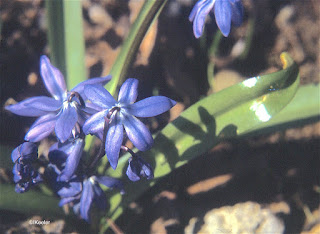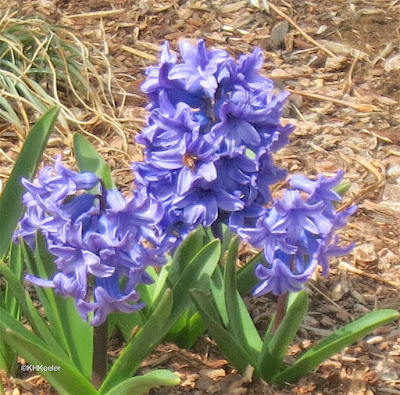 |
| garden hyacinth, Hyacinthus orientalis |
Who then is this much-imitated plant?
The garden hyacinth, also called the common hyacinth and Dutch hyacinth is Hyacinthus orientalis. (The other two species of Hyacinthus grow in the Middle East and are rare in cultivation.) The garden hyacinth grows up to two feet tall, with a cluster of bright flowers in the spring and a lovely scent. Originally all were blue-purple but cultivated varieties come in many colors (examples). The flowers have six petals that when fully open look like a star. They are native to the eastern Mediterranean region/ western Middle East, from central and southern Turkey and Syria south to Israel. Reportedly in the spring the hillsides of Galilee can be a sea of purple when they bloom. (See wild garden hyacinths in Israel: link)
Since it is a handsome plant and grows in the Holy Land, I expected a mention in the Bible. Most plants of the Bible sources online do not list it, but apparently experts have thought the "lily of the valleys" in the Song of Solomon (2:1-2) is the garden hyacinth (Moldenke and Moldenke, Swenson). Although you can find a half-dozen other theories of what plant was meant (link) the case for hyacinth is quite good. The 1939 American translation of the Bible, known as the Goodspeed version, a translation based on Greek texts, says hyacinths in many places where other editions say lilies. Likely they are indeed in the Old Testament.
Hyacinths reportedly were widely grown in ancient Greece and Rome but were introduced to northern Europe from Turkey in the 1500s. I was not satisfied I understood how these facts fit together so I went digging in the literature. I conclude: the plants of Greece and Rome were not the same as the modern plant called hyacinth. If you are only interested in the modern hyacinth, skip down to The Modern Plant.
The Greek Plant:
First, our modern hyacinth is not native to Greece or Rome. In the few Greek floras (lists of plants of a region) where I found it at all, it is described as a garden escape.
But the name hyacinth is certainly Greek.
The ancient Greeks told a story of a prince of Sparta, Hyakinthos, who loved and was loved by both Apollo, God of the Sun and Zephyr, God of the West Wind. Apollo and Hyakinthos were playing quoits (or discus) and Zephyr, jealous, pushed the disc and it hit Hyakinthos, killing him. Apollo, distraught, caused flowers to spring up from Hyakinthos' blood, so he would be forever remembered. The flowers were of course called hyacinths.
The problem is that experts doubt that the flower of the Greeks legend was the flower we now call a hyacinth. The legend further states that Apollo, crying "ai! ai!" (alas! alas!) in his distress, marked the flower with "A I", in black according to some, so it would always mourn. Common hyacinths do not have markings that can be interpreted as "A I": blue purple-flowers that have been suggested as the hyacinth of legend include iris (see photo link) and larkspur (link).
 |
| The Greek hyacinth might have been an iris |
 |
| The Greek hyacinth might have been a larkspur |
Generally people seem to assume that our garden hyacinth was the one commented on in antiquity. But it is not described. Homer mentions it once, "With this the son of Saturn [Jove] caught his wife in his embrace; whereon the earth sprouted them a cushion of young grass, with dew-bespangled lotus, crocus, and hyacinth, so soft and thick that it raised them well above the ground." (Iliad Ch. 14 (link)). In the Odyssey, Homer says Odysseus has "hyacinthine hair" (Odyssey 6.231 link) which has been interpreted as dark purple, although elsewhere Homer said Odysseus was blond, or curled like fully open garden hyacinth flowers. Eleanor Irwin (see references) argued that Homer just meant beautiful flowing hair, like a flower bursting into bloom, and I find her arguments convincing. Which means these quotes say nothing about what plant Homer called a hyacinth.
Dioscorides, a Greek physician for the Roman armies, in his Materia Medica (AD 64) called a plant hyacinthus, but that has been identified as the plant called scilla or squill in English (Scilla bifolia).
 |
| squill, Scilla biflora, Dioscorides' hyacinthus |
I conclude that our garden hyacinth was unknown in ancient Greece and Rome: they loved some other flower which they called a hyacinth.
The Modern Hyacinth
Come forward a thousand years. The word hyacinth first came into English (Middle English) as jacinth, used for both the gem and the flower. But the gem jacinth is reddish-orange, a variety of zircon (Oxford English Dictionary link). In the 1500s, the word again came into English, this time as hyacinth, via French, referring a blue gem (sapphire?) and also to the Hyakinthos legend (link). About this time, the garden hyacinth (Hyacinthus orientalis) reached Europe (1561 for England). It was grown in the courts of the Ottoman Empire in Constantinople--the Ottoman Emperors had extensive gardens, collected flowers, and reigned over the places the garden hyacinth is native. Botanically-oriented ambassadors brought it to Europe. Who first called this plant a hyacinth I cannot tell. Online Turkish dictionaries show a different word for hyacinth in Turkish (sümbül). But that is what I think happened, someone gave the name "hyacinth" to a previously unknown handsome blue-purple spring flower.
 |
| hyacinth Hyacinthus orientalis |
Garden hyacinths are also known as Dutch hyacinths because they are grown in great numbers in the Netherlands and have been since the 1500s. When you see patches of blue in the aerial photos of the Netherlands that are so popular this time of year (links) those are almost certainly hyacinths.
Hyacinths were the "must have" bulb in Holland in the early 1700s. The result was a "hyacinth bubble." The Dutch tulip bubble is much more famous, but hyacinths briefly commanded amazing prices too. Bulbs that sold for 100-200 guilders in 1716 cost 1-2 guilders in 1739 and did it again, with different varieties, between 1788 and 1815 (60-200 guilders dropping to 1-10). (Garber says this typical for a rare plant: very expensive until supply catches up with demand).
AND
Hyacinths commanded incredible prices again in 1997: three bulbs were bought for £150,000 by Thompson and Morgan (link, available from them as "Midnight Mystic"). (Story in The Telegraph)
£50,000 for a single hyacinth bulb certainly makes the point that this plant is loved and valued.
As well they should be: the flowers appear are in spring, when people are excited to see flowers. With multiple flowers massed on the stalk, they are dramatic. Hyacinths come in many colors (from white through reds and purples to black!) and as singles and doubles. They have a wonderful scent, unusual in a bright-colored flower. And since they grow from bulbs, you can have the same display spring after spring without additional work. Wow.
And I think that is why so many other plants have names relating them to hyacinths. I will write about those in future posts.
Comments and corrections welcome.
References
Doerflinger, F. The Hyacinth story. (from Adsurgens, Wycliffe Hall Botanical Gardens, 1989)
https://oldhousegardens.com/HyacinthHistory
Garber. P. M. 2001. Famous First Bubbles: Fundamentals of Early Manias. MIT Press, Cambridge, MA
Gunther, R. T. 1934. The Greek Herbal of Dioscorides. University Press, Oxford.
"hyacinth, n.". OED Online. March 2019. Oxford University Press. http://www.oed.com.libproxy.unl.edu/view/Entry/89783 (accessed March 15, 2019).
Irwin, M. E. 1990. Odysseus' "Hyacinthine Hair" in "Odyssey" 6.231. Phoenix. 44 (3): 205-218.
"jacinth, n.". OED Online. March 2019. Oxford University Press. http://www.oed.com.libproxy.unl.edu/view/Entry/100482 (accessed March 15, 2019).
Kentish, F. 2015. The £150k hyacinth: most expensive flowers and bulbs ever sold. The Telegraph (London) link
Moldenke, H. N. and A. L. Moldenke. 1952. Plants of the Bible. Chronica Botanica. (the 1986 paperback from Dover Publishers is the same book).
Swenson, A.A. 1995. Plants of the Bible. Citadel Press, New York.
Kathy Keeler, A Wandering Botanist
More at awanderingbotanist.com


Thank you. I enjoyed reading about the hyacinth :).
ReplyDeleteThank you for the wonderful read! Interestingly enough, I have been on my search for the hyacinth that the bible describes! So for your biblical representation, you will find the original book of John's (aka "of patmos") revelation: the book of Revelation, book 21, verse 20: the eleventh stone is NOT red zircon/or garnet. Some translations say "Jacinth" because some people call greek hyacinth "Jacinto" interchangeably. The real word John uses is in fact: ὑάκινθος; (hyakinthos). So I was on a quest for the color of the 11th stone for new Jerusalem's foundation. Thank you for the info on this beautiful flower! As I continue to dive down the rabbit hole to look for my definitive plant answer lol.
ReplyDelete